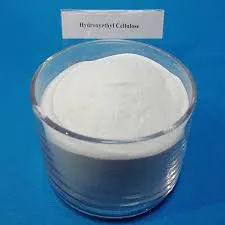
Desemba . 13, 2024 16:47 Back to list
hydroxyethyl cellulose manufacturing process
The Manufacturing Process of Hydroxyethyl Cellulose
Hydroxyethyl cellulose (HEC) is a water-soluble polymer derived from cellulose, a natural polymer most commonly obtained from wood pulp or cotton. With its unique properties, such as viscosity enhancement, thickening, and film-forming capabilities, HEC is widely used in industries ranging from pharmaceuticals to construction. Understanding the manufacturing process of hydroxyethyl cellulose is essential for ensuring product quality and efficacy.
Raw Materials
The primary raw material for HEC production is cellulose. Cellulose itself is composed of linear chains of β-D-glucose units linked by β(1→4) glycosidic bonds. The cellulose is typically sourced from wood or cotton. Other key ingredients include ethylene oxide, which is the etherifying agent used to modify cellulose. Additionally, water is an essential component during the dissolution and reaction processes.
Step 1 Cellulose Preparation
The manufacturing process begins with the purification of cellulose. Raw cellulose is subjected to chemical treatments to remove impurities such as lignin and hemicellulose. This is often achieved through processes including bleaching and alkaline treatment. Following purification, the cellulose is then dried, milled, and sieved to ensure uniform particle size before proceeding to the etherification stage.
Step 2 Etherification Reaction
In the etherification stage, purified cellulose is dissolved in a suitable solvent, which sometimes includes water or organic solvents. Ethylene oxide is then introduced to the cellulose solution. The reaction typically occurs under controlled temperature and pressure conditions to facilitate the substitution of hydroxyl groups (-OH) on the cellulose backbone with hydroxyethyl groups (-O-CH2-CH2-OH). This reaction is crucial, as it alters the polymer’s solubility and viscosity properties.
The reaction can be tailored by adjusting the ethylene oxide concentration, temperature, and reaction time. Higher concentrations of ethylene oxide result in a higher degree of substitution, which can lead to increased viscosity in the final product. This step is performed in specialized reactors, often equipped with stirring and temperature control mechanisms to ensure uniform reaction throughout the mixture.
hydroxyethyl cellulose manufacturing process

Step 3 Precipitation and Purification
After the etherification reaction is complete, the resulting hydroxyethyl cellulose is precipitated out of the solution. This is typically done by adding a non-solvent, such as acetone or alcohol, which causes HEC to become insoluble. The precipitated polymer is then filtered and washed to remove any unreacted ethylene oxide and byproducts.
Further purification steps may include drying and milling the resulting HEC. This ensures a consistent granule size, enhancing the ease of handling and blending with other ingredients during formulation.
Step 4 Quality Control and Packaging
Quality control is integral to the manufacturing process of hydroxyethyl cellulose. The final product is tested for viscosity, solubility, and purity to meet industry standards. Advanced analytical techniques, such as viscosity measurements using viscometers and molecular weight determination using gel permeation chromatography, may be employed to assess the characteristics of the final HEC product.
Once the product passes all quality control tests, it is packaged appropriately for distribution. HEC is typically stored in sealed bags or containers to prevent moisture absorption, which could affect its properties.
Conclusion
The manufacturing process of hydroxyethyl cellulose is a meticulously controlled operation that transforms natural cellulose into a versatile polymer. By understanding each step of the process—from raw material purification to rigorous quality control—manufacturers can ensure that the final product meets the diverse needs of various industries, enhancing product performance and customer satisfaction.
-
Versatile Hpmc Uses in Different Industries
NewsJun.19,2025
-
Redispersible Powder's Role in Enhancing Durability of Construction Products
NewsJun.19,2025
-
Hydroxyethyl Cellulose Applications Driving Green Industrial Processes
NewsJun.19,2025
-
Exploring Different Redispersible Polymer Powder
NewsJun.19,2025
-
Choosing the Right Mortar Bonding Agent
NewsJun.19,2025
-
Applications and Significance of China Hpmc in Modern Industries
NewsJun.19,2025







